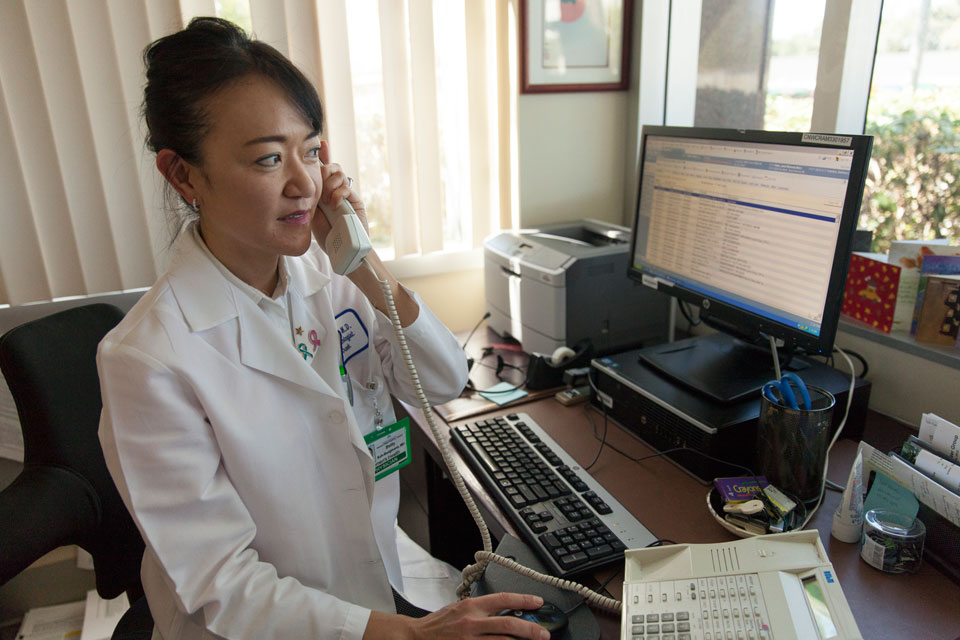Elizabeth “Betty” Suh-Burgmann, MD, says her latest research project was “born out of frustration with the state of affairs” for managing adnexal masses in women.
Like gynecological oncologists across the nation, Dr. Suh-Burgmann saw many women at her Kaiser Permanente Walnut Creek practice undergo surgeries to determine whether small masses in their ovaries were benign or cancerous.
“Based on an ultrasound or biomarker testing alone, it’s often difficult to distinguish between the two without testing the tissue,” says Dr. Suh-Burgmann, who serves as administrative chair of Kaiser Permanente Northern California’s gyn-onc subspecialty group.
And because ovarian cancer is so challenging to treat, doctors were worried about taking the chance of missing the small percentage of those smaller tumors that did turn out to be cancerous.
This is where the “frustration” kicked in for Dr. Suh-Burgmann, who has integrated research into her clinical career from the beginning. She wanted to know how many of these small masses actually turned out to be cancer, so she could determine how often surgery is really necessary. She also wanted to know how long a mass needed to be monitored to rule out malignancy.
With no prior studies on these questions in a real-world cohort, Dr. Suh-Burgmann turned to Kaiser Permanente’s database—KP HealthConnect—which she calls “a tremendous resource for research.” She reviewed radiology scans for Kaiser Permanente members in Northern California who were over age 50 and had masses smaller than 6 centimeters.
Of the 1,363 scans she reviewed, only seven were cancerous—or 0.5 percent. There were 11 borderline tumors which can, in rare cases, progress to cancer. Including the borderline tumors, the cancer rate was 1.3 percent. And all malignancies demonstrated growth on ultrasound within 7 months.
The resulting peer-reviewed research article, which Dr. Suh-Burgmann wrote with the assistance of statisticians in the Kaiser Permanente Division of Research, was published in the American Journal of Obstetrics and Gynecology in 2014. TPMG awarded her the Morris F. Collen Research Award for this work in 2015.
Based on her findings, Dr. Suh-Burgmann worked in partnership with a multidisciplinary team of radiologists and gynecologists. They developed and implemented guidelines to improve how TPMG physicians use ultrasound to monitor ovarian masses to better detect worrisome tumors, while avoiding unnecessary surgery. These guidelines are now fully implemented throughout Northern California.
“As physicians, we have an obligation to evaluate our practice,” she says. “I feel very lucky to be in an organization that not only supports research, but also really makes it possible to translate research into improvements in patient care.”
Team approach to clinical excellence
Dr. Suh-Burgmann says her ability to do this type of cutting-edge research is also due, in part, to working in an integrated and technologically advanced health care environment with a team that constantly seeks new and innovative ways to improve care.
Tracy Flanagan, MD, an obstetrician-gynecologist and director of Women’s Health for Kaiser Permanente Northern California, agrees, adding, “Being part of TPMG gives us the opportunity to straddle the worlds of delivering care and improving the quality of care.”
TPMG’s gyn-onc subspecialty currently includes 16 fellowship-trained surgeons who are double-board-certified in obstetrics gynecology and gynecological oncology. They are based at five centers throughout the region—Oakland, Sacramento, San Francisco, Santa Clara and Walnut Creek—and saw more than 1,700 patients in 2015, making this subspecialty one of the largest practices of its kind in the nation.
“By virtue of our integrated system, we’ve been able to leverage our regional coordination and access to data to systematically improve women’s health care,” Dr. Suh-Burgmann says. “It matters that we’re all working together at the regional level.”
“On their own, the gyn-onc group has deliberately taken a regional perspective,” says Philip Madvig, MD, associate executive director at TPMG. “This allows them to hire subspecialists as needed, to locate services where needed, and to use the data from our entire population to identify the best opportunities for improvement, and then get that improved care implemented.”
For example, TPMG’s gyn-onc subspecialists launched a robotic surgery program for the region in 2008, proctoring and mentoring each other on the equipment until all were trained. Last year they performed about 950 robotic surgeries. Likewise, previous open surgical procedures have been systematically converted to a minimally invasive approach, resulting in improved post-surgical recovery times and reduced surgical complications for patients.
Integrating research and clinical care
In addition to her clinical and research duties, Dr. Suh-Burgmann also serves as co-chair of Kaiser Permanente’s Institutional Review Board, which reviews all human subjects research within Kaiser Permanente, and the chair of the Central Research Committee, which provides assistance and grants to clinician research projects. She works closely on her research projects with colleagues at the Division of Research, who assist staff and clinicians with grant proposals, study design, data collection, statistical analysis and more.
Dr. Madvig encourages clinicians to integrate quality improvement and research into their clinical careers. “Research has been part of the DNA of The Permanente Medical Group and Kaiser Permanente since our earliest days,” he says. “We are continuously seeking innovative ways to partner research and clinicians in all areas of the organization, to develop the kinds of industry-leading, patient-centered quality outcomes that we have seen in women’s health care.”
Now that the system for managing adnexal masses has been implemented across Northern California, Dr. Suh-Burgmann is looking toward the future. Her next steps are to analyze the resulting data, publish the results, and work toward further improving the system and developing national guidelines.
“Standardization of reporting and management has been found to be critical in ensuring appropriate follow-up of abnormal radiology findings, such as abnormal mammograms and lung nodules. While others have proposed implementing something similar for the management of adnexal masses, we are, to my knowledge, the first to implement such a system on a large scale. This standardization will yield the data that is needed to understand how to optimize management of women with these findings.”
*This article originally appeared in Permanente Excellence, Fall 2016





This Post Has 0 Comments